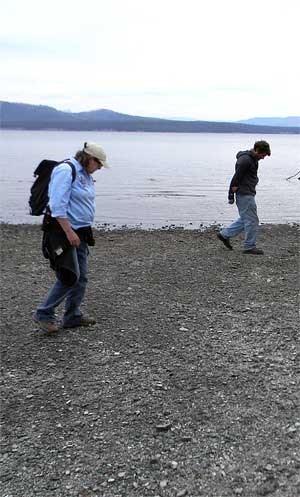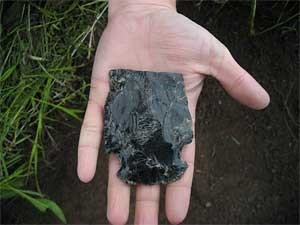Last updated: March 6, 2023
Article
The Montana-Yellowstone Archeological Project at Yellowstone Lake

Doug MacDonald photo.
At 7,750 feet above sea level, and covering almost 300 square miles, Yellowstone Lake, in Wyoming, is North America’s largest high-elevation lake. Because of the numerous archeological sites that ring its 124 mile circumference, archeologist have long sought to understand the lake’s role in the seasonal subsistence and settlement patterns of the region’s many Native American groups. For the past five years, the Montana-Yellowstone Archaeological Project (MYAP) has focused on research from Yellowstone Lake. Researchers from the University of Montana have worked with Yellowstone National Park cultural resources staff to identify and investigate archeological sites around the lake’s shores. The project is focused on defining the role of Yellowstone Lake in the lifeways of Native Americans who lived within the northwestern Great Plains, the northern Rocky Mountains, and the far northeastern edge of the Great Basin.
Using ethnohistoric (information derived from the study of native peoples from a historical and anthropological perspective) and archeological data, researchers are evaluating four key questions about the use of Yellowstone Lake in prehistory:
- Where did Native Americans come from to get to the lake?
- How were the lake and environs subsistence resources used?
- How did the earliest visitors get to the lake’s islands?
- What was the primary mode of travel while at the lake?
A variety of investigations have been carried out to test hypotheses to answer these questions.
Environment and Research
Yellowstone Lake is the heart of the Greater Yellowstone ecosystem, which encompasses nearly 31,000 square miles within northwestern Wyoming, south central Montana, and northeastern Idaho. The lake is bordered by the Absaroka Mountains to the east and the Teton Range to the south.
The Yellowstone River flows into the lake on its southeast corner, and exits about 18 miles to the northeast. Due to variations in glacier behavior and climate change, water levels have fluctuated significantly during the last 13,000 years, resulting in a series of terraces and paleo-shorelines around the lake. The lake contains six islands, but only three of any significant size.
The shores of the lake contain several vegetation zones, including a moist subalpine fir zone and a forested riparian zone, as well as grassy and sagebrush or shrub and grass habitats. Interspersed among the extensive pine forests that enclose the lake, these open meadows and riparian areas are extremely diverse, containing as many as 400 plant species. During 2009, MYAP researchers studying plant resources in the vicinity of the lake identified 52 plant species within a 20 acre meadow on the northwest shore of the lake. Of these, 15 were food sources, 17 were medicinal, and 8 species were known to be spiritually important.
This diversity of plant resources supports more than 60 mammal species, including bison, elk, moose, big horn sheep, deer, antelope, grizzly and black bear, mountain lion, coyote, and wolf. Another seasonally migratory resource in Yellowstone Lake is cutthroat trout, one of only two surviving native cutthroat trout species left in North America.
More than 285 archeological sites have been identified along the shores of the lake and on the islands. Recent excavations at dozens of lake area sites confirm active use of the lake and the area for the last 10,000 years.
Where did Native Americans come from to get to the lake?
Recent ethnographic and archeological studies indicate that a number of historically-known tribes and their ancestors spent extensive time here. The stone tool data suggest that tribal peoples from the north—Blackfeet, Salish; south—Shoshone, Bannock; east—Crow, Shoshone; and west—Nez Perce—visited Yellowstone Lake, probably following routes still used today along the Madison, Yellowstone, Gardiner, and Shoshone rivers.
People camping on the north shore were likely Plains-adapted hunter-gatherers, spending most of their time in the northern Yellowstone Valley and vicinity. Those camping on the east shore of the lake were likely inhabitants of the plains as well, including the hot and dry portions of northwestern Wyoming, such as the Big Horn Basin. Tribal groups on the southeast lakeshore were probably residents of the Jackson Hole area and points south. Groups on the southwest and western shores may have come from the north, south, and west, including the northern Great Basin of eastern Idaho.
The stone tool and ethnohistorical data, therefore, do not support a hypothesis that Yellowstone Lakes was the center of a large territory used by a single group. Rather, the lake and environs were at the crossroads of multiple territories.

Doug MacDonald photo.
How were the lake and environs subsistence resources used?
Yellowstone Lake is frozen several feet thick between early December and mid to late May, suggesting that Native Americans would most likely have utilized the lake’s resources in the other six warmer months.
Hunting bears just as they emerge from hibernation was widely incorporated into the rounds of northern latitude hunter-gatherers around the world. Bears have been observed on three islands, and at least one island had a hibernation den. Hibernating bears certainly would have encouraged humans to traverse ice, especially if the hunter had pre-scouted the presence of a den prior to snowfall. Among many Native American cultures, the killing of a bear was often not just for food but also perceived to bring wisdom and strength to the hunter. Bear is also the second most common type of protein identified on stone tools at Yellowstone Lake sites, suggesting that bear hunting was fairly common. Thus, the archeological sites on the islands may be associated with bear hunting.
Yellowstone cutthroat trout were abundant in the lake and especially easy to catch in the spring when they ran up the lake’s creeks to spawn. Prior research had suggested that fishing for the plentiful trout was the main reason Native Americans came to the lake. While it is clear from the ethnohistorical data that Shoshone and Bannock tribe people knew that the lake contained fish, it is not clear that people fished there. No archeological sites yielded bones of fish native to the lake; likewise, stone tools examined for protein residues did not yield protein of native fish.
Site spatial data was used to evaluate the hypothesis that Native Americans fished at Yellowstone Lake. If people came to the lake in order to fish, particularly in the spring when trout left the lake in large numbers to spawn in tributary creeks, camp sites should be situated at the mouths of the streams. However, there was not a significant correlation between site location and stream confluences. The spatial data indicated that the presence of open/riparian habitats was a better predictor for locating archeological sites. These habitats provided abundant plant and animal resources for hunter-gatherers. Blue camas, one of the key edible plants in meadows, was especially attractive for the Bannock and Shoshone peoples. Other plants, including bitterroot, that ripens in the spring, likely inspired movement into the upland from base camps in lower elevation valleys.
Another means by which to identify fishing activities is the presence of fishing tools in the archeological record. No net sinkers or other fishing tools have been recovered during archeological survey of the lake shore and excavation at dozens of sites. The closest site containing a recognizable net sinker is on Malin Creek, a tributary of the Yellowstone River, 20 miles downstream of the lake. The Smithsonian Institution also holds two possible fishing tools from Yellowstone National Park—a notched stone and a fishing lure—but they are not well-provenienced, and the age, location, and cultural origin are unknown.
There is no evidence to indicate that fishing comprised a substantial portion of the prehistoric diet for Native Americans at Yellowstone Lake. However, the absence of fishing evidence does not necessarily refute the hypothesis that fishing occurred. Tools produced from organic materials could have been exclusively for fishing, and the refuse from fish predation may have been consumed by dogs or birds, or subject to the vagaries of preservation. Fish weirs have never been conclusively identified at feeder streams of the lake, but it is likely that such rock features would have been destroyed by the force of spring run-off and not preserved in the archeological record.
In conclusion, MYAP research suggests that Native American subsistence at Yellowstone Lake was oriented around land-based resources within open riparian habitats. Bear hunting and camas collecting in early spring were likely important activities. There is no evidence to suggest that fishing was an important activity, at least in the spring.
How did the earliest visitors get to the lake’s islands?
Similar to fishing, no archeological evidence of boats or boat-building tools have ever been found at sites around the lake. While small, simple boats may have been used, there is no evidence that canoes or other heavy-duty boats were employed for extensive travel around the lake. Access to the lake’s islands was most likely on foot across ice in early spring.
What was the primary mode of travel while at the lake?
Mobility around the lake shore via boats was unlikely, as best demonstrated by the distribution of tools made from stone from specific sources in lake shore sites. The MYAP lithic study encompasses more than 24,000 artifacts from 28 well-studied sites around the lake. The north shore of the lake is closest to the famous Obsidian Cliff, far and away the most popular location for collection of stone for tools by Native Americans in northern Yellowstone. The distribution of obsidian lithic materials is much higher at sites on the north shore of the lake, and closest to the obsidian source. If boats were used to transport stone, the proportion of the highly-preferred obsidian at sites on the north side and the south side of the lake should be nearly equal, as large loads of stone could be carried, and even used as ballast. The unequal proportions suggest that obsidian was carried on foot around the lake.
The obsidian source analysis also suggests that people traveled directly to the lake, stayed on one spot, and left in the same direction from which they came. People arriving from the north mostly used stone from the north, and people arriving from the south mostly used stone from the south. At certain times in history, it is entirely possible that many people used the expansive lake area without encountering another group. Conversely, it is clear from the lithic analysis that at other times Native Americans from other regions actively traded and socialized with each other, as small amounts of exotic stone are present at most lake area sites. These materials were most likely procured through trading networks.
Conclusion
Overall, MYAP is helping to resolve key questions about Native American use of Yellowstone Lake. Native Americans have used the lake and environs’ resources for at least the last 11,000 years. Native Americans traveled from the north, south, east, and west to take advantage of seasonal resources at the lake, and most travel around the lake was on foot. These trips were likely initiated by hunters in the early spring, hoping to kill bears coming out of hibernation; this may be what attracted hunters to the islands.
The archeological data do not support the hypothesis that Native Americans actively fished at the lake or used boats. Instead, what may have attracted people to the area were the plant and animal resources readily available around the lake. Further research will attempt to resolve the question of how long cutthroat trout have lived in the lake, a question still unanswered.
By Douglas MacDonald, University of Montana
